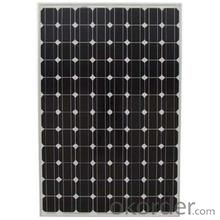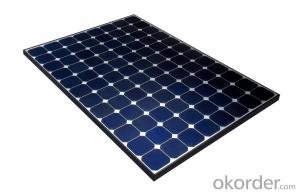CNBM On Grid System 70000W with Certificate UL TUV CE
- Loading Port:
- Shanghai
- Payment Terms:
- TT OR LC
- Min Order Qty:
- 10 watt
- Supply Capability:
- 1000 watt/month
OKorder Service Pledge
OKorder Financial Service
You Might Also Like
Item specifice
CNBM On Grid System 70000W with Certificate UL TUV CE
Product description
A photovoltaic (in short PV) module is a packaged, connected assembly of typically 6×10 solar cells. Solar Photovoltaic panels constitute the solar array of a photovoltaic system that generates and supplies solar electricity in commercial and residential applications. Each module is rated by its DC output power under standard test conditions, and typically ranges from 100 to 365 watts. The efficiency of a module determines the area of a module given the same rated output – an 8% efficient 230 watt module will have twice the area of a 16% efficient 230 watt module. There are a few commercially available solar panels available that exceed 22% efficiency[1] and reportedly also exceeding 24%.[2][3] A single solar module can produce only a limited amount of power; most installations contain multiple modules. A photovoltaic system typically includes a panel or an array of solar modules, a solar inverter, and sometimes a battery and/or solar tracker and interconnection wiring.
The price of solar power, together with batteries for storage, has continued to fall so that in many countries it is cheaper than ordinary fossil fuel electricity from the grid (there is "grid parity").[4]
Off-the-grid is a system and lifestyle[1] designed to help people function without the support of remote infrastructure, such as an electrical grid. In electricity, off-grid can be stand-alone power system or mini-grids typically to provide a smaller community with electricity. Off-grid electrification is an approach to access electricity used in countries and areas with little access to electricity, due to scattered or distant population. The term off-the-grid (OTG) can refer to living in a self-sufficient manner without reliance on one or more public utilities. People who adopt this lifestyle are called off-gridders.[2]

Application
Industrial
Commercial
Residential
Feature
Residential, grid-connected rooftop systems which have a capacity more than 10 kilowatts can meet the load of most consumers.[2] They can feed excess power to the grid where it is consumed by other users. The feedback is done through a meter to monitor power transferred. Photovoltaic wattage may be less than average consumption, in which case the consumer will continue to purchase grid energy, but a lesser amount than previously. If photovoltaic wattage substantially exceeds average consumption, the energy produced by the panels will be much in excess of the demand. In this case, the excess power can yield revenue by selling it to the grid. Depending on their agreement with their local grid energy company, the consumer only needs to pay the cost of electricity consumed less the value of electricity generated. This will be a negative number if more electricity is generated than consumed.[3] Additionally, in some cases, cash incentives are paid from the grid operator to the consumer.
Packaging
With carton and box
- Q:How do solar energy systems affect the carbon footprint?
- Solar energy systems significantly reduce carbon footprint. They generate electricity by harnessing the sun's energy, which is a clean and renewable source. This eliminates the need for fossil fuels, such as coal and natural gas, that release harmful carbon dioxide emissions when burned. By using solar energy, we can minimize greenhouse gas emissions and combat climate change.
- Q:How do solar energy systems store excess energy?
- Solar energy systems store excess energy by using batteries or a process called net metering. With batteries, the excess energy generated by the solar panels is stored in these batteries for later use when the panels are not producing enough energy, such as during the night or on cloudy days. Net metering, on the other hand, allows the excess energy to be fed back into the grid, where it is credited to the owner's account. This excess energy can then be used at a later time when the solar panels are not producing enough power.
- Q:Can solar energy systems be used in powering religious institutions like churches or temples?
- Yes, solar energy systems can certainly be used to power religious institutions like churches or temples. In fact, solar power is an ideal solution for these buildings as they often have large roofs that can accommodate solar panels. By installing solar energy systems, religious institutions can significantly reduce their electricity bills, save money, and become more sustainable. Solar panels generate electricity by converting sunlight into usable energy. This energy can be used to power the lighting, heating, cooling, and other electrical needs of the religious institution. With advancements in solar technology, it is now possible to store excess energy in batteries, ensuring uninterrupted power even during cloudy days or at night. Using solar energy not only reduces the operational costs of the religious institution but also helps in reducing its carbon footprint. By reducing dependency on fossil fuels, solar power systems contribute to mitigating climate change and promoting environmental stewardship. This aligns with the core values of many religious organizations that emphasize the importance of environmental sustainability and being responsible stewards of the Earth. Furthermore, solar energy systems can serve as a visible example of the religious institution's commitment to sustainable practices, inspiring its members and the wider community to adopt renewable energy solutions. By utilizing solar power, religious institutions can demonstrate their dedication to caring for the planet and encouraging others to follow suit. In summary, solar energy systems can be successfully used to power religious institutions like churches or temples. They offer an environmentally-friendly and cost-effective solution that aligns with the values of many religious organizations. By embracing solar power, these institutions can reduce their energy costs, promote sustainability, and inspire their members and the community to adopt clean energy solutions.
- Q:How do solar energy systems impact the demand for fossil fuels?
- Solar energy systems have a significant impact on the demand for fossil fuels as they provide a clean and renewable source of energy. By harnessing the power of the sun, solar energy systems reduce the need for traditional fossil fuel-based electricity generation. As a result, the demand for fossil fuels decreases, leading to reduced carbon emissions and a more sustainable energy future.
- Q:How do solar energy systems impact the reliability of the electricity grid?
- Solar energy systems can have both positive and negative impacts on the reliability of the electricity grid. On one hand, solar energy systems can enhance grid reliability by diversifying the energy sources and reducing reliance on traditional fossil fuel-based generation. This can help to mitigate the risk of disruptions caused by fuel supply shortages or price fluctuations. Additionally, solar energy systems can often be installed at or near the point of energy consumption, reducing transmission and distribution losses and improving overall system efficiency. On the other hand, solar energy systems also present challenges to grid reliability. As solar power generation is intermittent and dependent on weather conditions, grid operators need to manage fluctuations in solar output to ensure a stable electricity supply. This requires the integration of smart grid technologies, energy storage systems, and advanced forecasting methods to balance supply and demand. Failure to effectively manage these challenges can result in voltage fluctuations, grid instability, and potential grid failures. Overall, with proper planning, grid integration, and technological advancements, solar energy systems can positively contribute to the reliability of the electricity grid. However, careful management and investment in grid infrastructure and energy storage solutions are essential to address the intermittency issues associated with solar power generation.
- Q:What is the role of inverters in solar energy systems?
- The role of inverters in solar energy systems is to convert the direct current (DC) electricity generated by the solar panels into alternating current (AC) electricity, which can be used to power homes, businesses, and other electrical appliances. Inverters also ensure that the AC electricity produced matches the frequency and voltage requirements of the electrical grid, enabling seamless integration and distribution of solar power.
- Q:How much do solar energy systems cost?
- The cost of solar energy systems varies depending on several factors such as the size of the system, the location, and the specific components used. On average, a residential solar system can range from $15,000 to $25,000 after accounting for federal tax incentives and other rebates. However, it's important to note that prices have been declining rapidly in recent years, making solar energy more affordable and cost-effective in the long run.
- Q:Can solar energy systems be used in areas with limited access to solar fuses and breakers?
- Yes, solar energy systems can be used in areas with limited access to solar fuses and breakers. While fuses and breakers are important components for safety and protection in solar energy systems, alternative methods can be employed to ensure safe and efficient operation. These may include using other types of protective devices or implementing innovative system designs that minimize the need for fuses and breakers. Additionally, regular maintenance and monitoring can help identify and rectify any issues that may arise in the absence of traditional protective devices.
- Q:Can a solar energy system be installed in areas with high pollution levels?
- Solar energy systems can be installed in areas with high pollution levels. Although pollution can decrease the efficiency of solar panels, it does not entirely hinder their functionality. Even in polluted areas, solar panels can still produce electricity, albeit with slightly lower output compared to cleaner environments. It is important to note that pollution can lead to the accumulation of dust and dirt on the surface of solar panels, further reducing their efficiency. Regular cleaning and maintenance of the panels can help address this issue and ensure optimal performance. Moreover, the installation of solar energy systems in areas with high pollution levels offers additional benefits. By utilizing solar power instead of traditional fossil fuel-based sources, it can contribute to the reduction of overall pollution levels and improve long-term air quality. This can have positive effects on both human health and the environment. In conclusion, although pollution can affect the efficiency of solar energy systems, they can still be installed and generate electricity in areas with high pollution levels. Additionally, the adoption of solar power can aid in pollution reduction and enhance the overall environmental conditions in such areas.
- Q:Can solar energy systems be combined with other renewable energy sources?
- Yes, solar energy systems can be combined with other renewable energy sources. This combination is known as hybrid renewable energy systems. By integrating solar with other sources such as wind, hydro, or geothermal energy, we can maximize the generation of clean and sustainable power while ensuring a more stable and reliable energy supply. This approach allows for better utilization of resources and enhances the overall efficiency of the renewable energy system.
1. Manufacturer Overview |
|
|---|---|
| Location | |
| Year Established | |
| Annual Output Value | |
| Main Markets | |
| Company Certifications | |
2. Manufacturer Certificates |
|
|---|---|
| a) Certification Name | |
| Range | |
| Reference | |
| Validity Period | |
3. Manufacturer Capability |
|
|---|---|
| a)Trade Capacity | |
| Nearest Port | |
| Export Percentage | |
| No.of Employees in Trade Department | |
| Language Spoken: | |
| b)Factory Information | |
| Factory Size: | |
| No. of Production Lines | |
| Contract Manufacturing | |
| Product Price Range | |
Send your message to us
CNBM On Grid System 70000W with Certificate UL TUV CE
- Loading Port:
- Shanghai
- Payment Terms:
- TT OR LC
- Min Order Qty:
- 10 watt
- Supply Capability:
- 1000 watt/month
OKorder Service Pledge
OKorder Financial Service
Similar products
New products
Hot products
Related keywords





























